How To Avoid PCB Exposure
- Last Updated: July 14th, 2025

Attorney Jessie Paluch, founder of TruLaw, has over 25 years of experience as a personal injury and mass tort attorney, and previously worked as an international tax attorney at Deloitte. Jessie collaborates with attorneys nationwide — enabling her to share reliable, up-to-date legal information with our readers.
Legally Reviewed
This article has been written and reviewed for legal accuracy and clarity by the team of writers and legal experts at TruLawsuit Info and is as accurate as possible. This content should not be taken as legal advice from an attorney. If you would like to learn more about our owner and experienced injury lawyer, Jessie Paluch, you can do so here.
Fact-Checked
TruLawsuit Info does everything possible to make sure the information in this article is up to date and accurate. If you need specific legal advice about your case, contact our team by using the chat on the bottom of this page. This article should not be taken as advice from an attorney.
Key Takeaways:
- Check local advisories for fish and water quality to avoid consuming PCB-contaminated items.
- Regularly test and update school facilities to prevent PCB exposure in children.
- Dispose of old electrical equipment properly, as it may contain PCBs.
Overview of Avoiding PCB Exposure
Question: How can you avoid PCB exposure?
Answer: To avoid PCB exposure, it’s important to follow preventive measures both at home and in the workplace.
At home, maintain good ventilation when dealing with products containing PCBs, wear protective gear, and follow advisories related to the consumption of fish or wildlife from contaminated locations.
In the workplace, eliminate or isolate PCBs, use special PCB-resistant gloves and clothing, maintain adequate ventilation during cleanup, and take steps for proper decontamination or disposal of contaminated equipment.
On this page, we’ll discuss this question in further depth, an overview of what PCB is, potential health risks associated with PCB exposure, and much more.
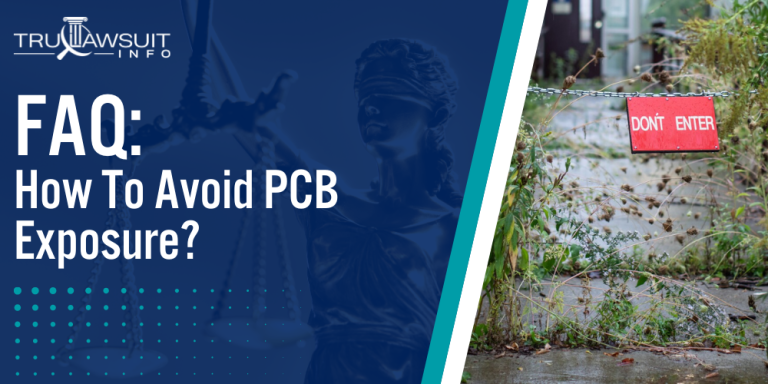
Intro to PCB Exposure
Polychlorinated biphenyls (PCBs) are a group of man-made chemicals that pose significant health risks to humans and the environment.
Often found in older electrical equipment, PCBs were widely used for their insulating properties until their production was banned in 1979 due to the dangers they presented.
If you or a loved one has experienced adverse health conditions after being exposed to PCB chemicals, you may be eligible to pursue compensation.
Contact TruLawsuit Info today using the chat on this page to receive an instant case evaluation.
Table of Contents
Health Impacts of Prolonged PCB Exposure
Prolonged exposure to polychlorinated biphenyls (PCBs) has been linked with a variety of adverse health impacts, significantly affecting the human body and posing severe long-term health risks.
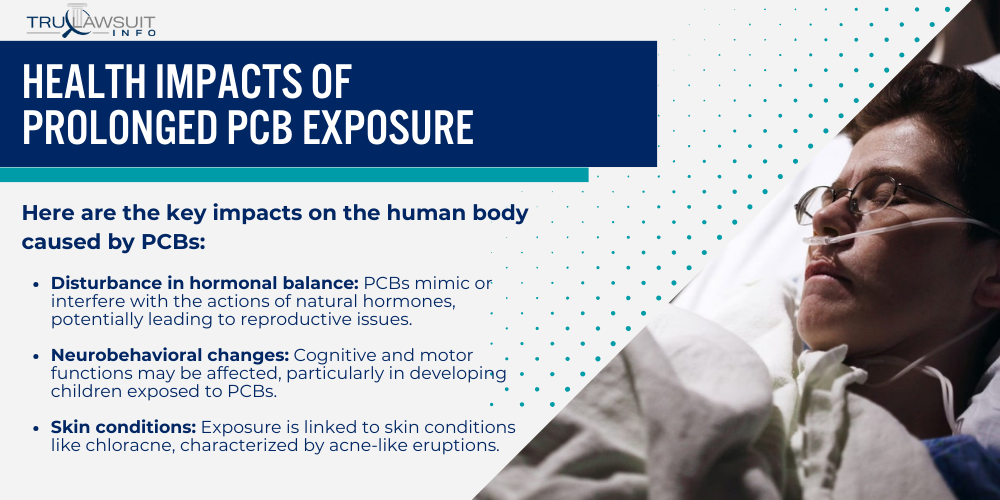
Effects on the Human Body
Exposure to PCBs predominantly disrupts endocrine function and can have a variety of toxic effects on the human body.
The immune system often suffers, leading to decreased resistance to infections.
Here are the key impacts on the human body caused by PCBs:
- Disturbance in hormonal balance: PCBs mimic or interfere with the actions of natural hormones, potentially leading to reproductive issues.
- Neurobehavioral changes: Cognitive and motor functions may be affected, particularly in developing children exposed to PCBs.
- Skin conditions: Exposure is linked to skin conditions like chloracne, characterized by acne-like eruptions.
- Eye irritation: PCBs can cause irritation and discomfort in the eyes after direct contact.
Long-Term Health Risks
Individuals subjected to prolonged PCB exposure face an increased risk of developing severe long-term health conditions.
The gravity of these health risks calls for ongoing monitoring and research.
These long-term health risks include:
- Cancer: PCBs are classified as probable human carcinogens, meaning long-term exposure increases the risk of certain types of cancer.
- Liver damage: There is empirical evidence suggesting a higher incidence of liver disease like cirrhosis in PCB-exposed individuals without any noticeable symptoms.
- Cardiovascular issues: Some studies show an association between PCB exposure and an increased risk of heart disease.
- Reproductive harm: PCBs have been documented to negatively impact the reproductive systems, potentially leading to infertility and other reproductive disorders.
- Immune dysfunction: Chronic exposure weakens the immune response, increasing susceptibility to infectious diseases and perhaps autoimmunity.
Avoiding Sources of PCB Exposure
To effectively reduce human exposure to PCBs, identifying and avoiding the primary sources of PCB contamination is crucial.
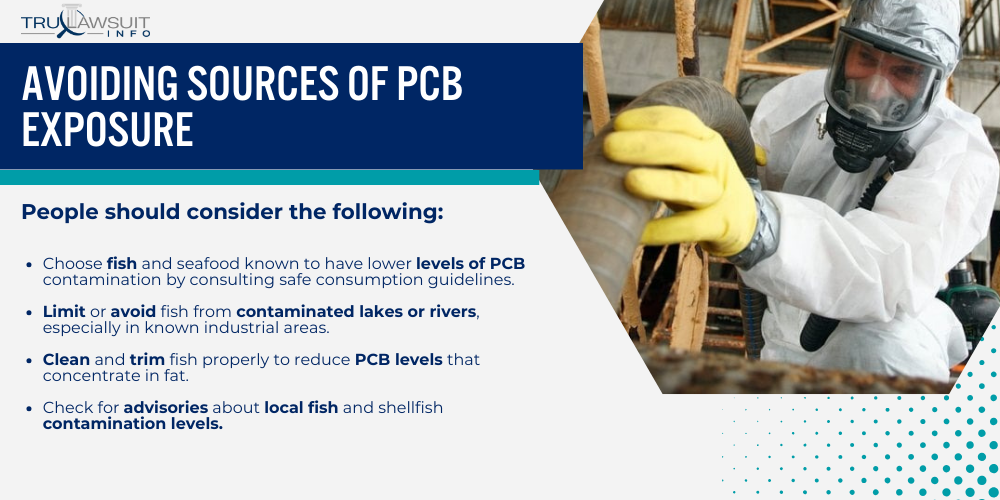
Whether through ingestion of contaminated fish in the food chain, presence in certain workplaces, or environmental contamination levels, understanding these pathways is essential for prevention.
Contaminated Food Chains
PCBs can often enter the human body through the food chain, particularly through the consumption of contaminated fish.
People should consider the following:
- Choose fish and seafood known to have lower levels of PCB contamination by consulting safe consumption guidelines.
- Limit or avoid fish from contaminated lakes or rivers, especially in known industrial areas.
- Clean and trim fish properly to reduce PCB levels that concentrate in fat.
- Check for advisories about local fish and shellfish contamination levels.
Occupational Hazards
Certain occupations may pose a higher risk of exposure to PCBs due to the nature of the work environment.
Workers should consider the following:
- Identify if their workplace uses or has used equipment containing PCBs, such as transformers and capacitors.
- Follow occupational health and safety regulations and use personal protective equipment for those items which are contaminated with pcbs.
- Participate in workplace training programs about the proper handling of PCBs.
- Advocate for regular monitoring of PCB levels in the workplace and for PCB elimination where possible.
Environmental Contamination
Contamination levels in the soil and air can be a less direct, yet still troubling source of PCB exposure.
To minimize these risks:
- Properly dispose of any materials that may contain PCBs according to local regulations.
- Support community and government initiatives to clean up contaminated sites.
- Encourage the use of air filters, especially in areas close to potential PCB sources.
- Minimize direct contact with potentially contaminated soil, and promote soil testing in residential areas.
Effective PCB Exposure Prevention
Exposure to polychlorinated biphenyls, or PCBs, can pose significant health risks.
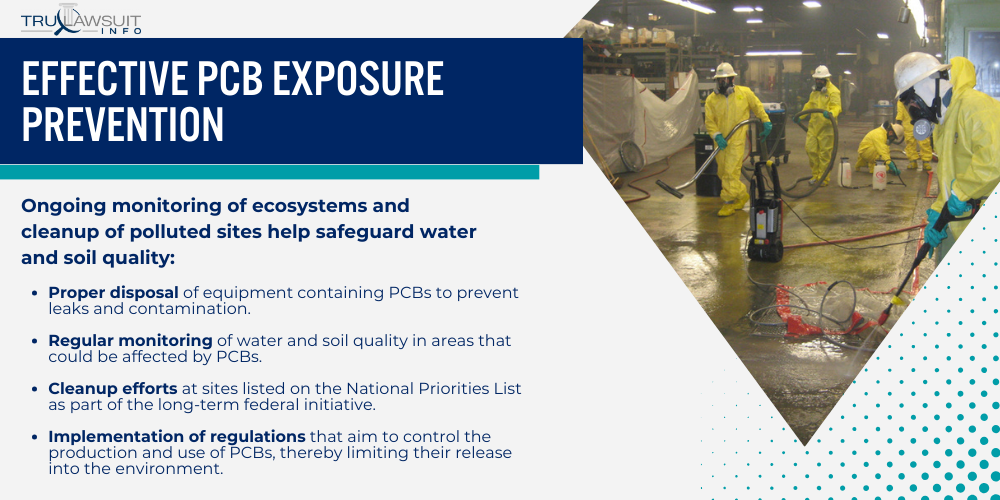
Effective prevention strategies are essential for both environmental and individual safety.
This section outlines the measures that can be taken to reduce these risks through environmental initiatives, workplace protocols, and public health guidelines.
Environmental Protection Measures
Protecting the environment from PCBs involves a multi-faceted approach.
Careful disposal of PCB-containing equipment is crucial to prevent environmental contamination.
Ongoing monitoring of ecosystems and cleanup of polluted sites help safeguard water and soil quality:
- Proper disposal of equipment containing PCBs to prevent leaks and contamination.
- Regular monitoring of water and soil quality in areas that could be affected by PCBs.
- Cleanup efforts at sites listed on the National Priorities List as part of the long-term federal initiative.
- Implementation of regulations that aim to control the production and use of PCBs, thereby limiting their release into the environment.
Workplace Safety Protocols
Maintaining a safe workplace requires diligent efforts to eliminate or control PCB exposure.
Implementing engineering solutions and providing personal protective equipment are essential steps for worker protection.
Regular maintenance and inspections reduce the risk of PCB leaks in the workplace:
- Elimination of PCBs from the workplace is the ideal protective measure.
- When elimination is not feasible, engineering controls should be put in place to contain PCB exposure.
- The provision of special PCB-resistant gloves and protective clothing for employees is critical when direct contact with PCBs is possible.
- Establishment of preventive maintenance programs and regular equipment checks to identify and mend potential leaks or PCB-containing equipment.
Public Health Recommendations
Reducing PCB exposure in communities involves clear communication, advisories, and education.
Advising against the consumption of contaminated fish and issuing health notices are vital.
Educational outreach increases awareness of PCB risks and prevention strategies include:
- Individuals are advised to avoid consuming fish from contaminated waters, particularly species known to accumulate higher levels of PCBs.
- Public health notices and community advisories should be disseminated in areas where reducing exposure to PCBs is of prime concern.
- Educational programs about the risks associated with PCB exposure and ways to minimize risk can help inform and protect the public.
- The promotion of PCB safety by Illinois Environmental Protection Agency and other agencies at the state level plays a key role in managing public health risks and informing the community.
Avoiding Exposure While Removing PCB Chemicals
When removing PCB chemicals, it’s critical to follow stringent protocols to minimize exposure.
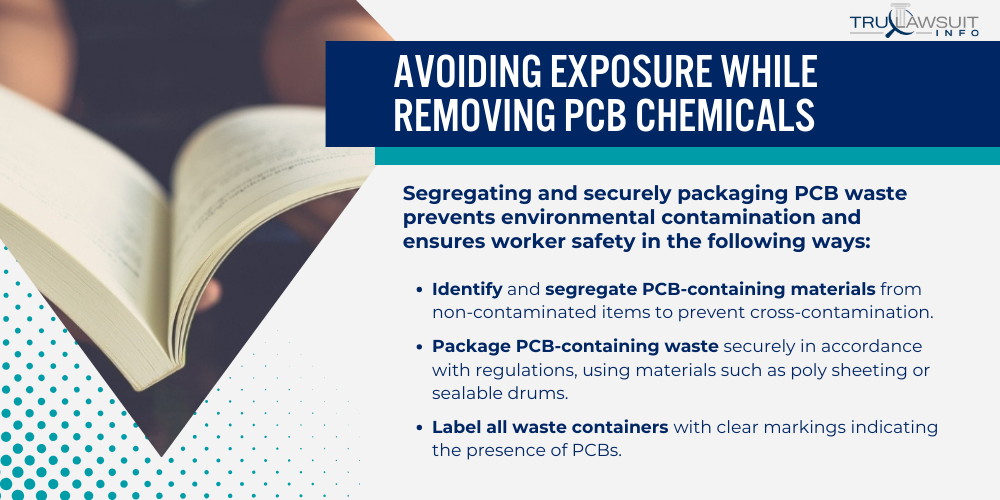
This involves specific methods for proper disposal and careful handling of PCB-containing equipment.
Proper Disposal and Cleanup
Effective disposal and cleanup are key to safely removing PCBs.
Segregating and securely packaging PCB waste prevents environmental contamination and ensures worker safety in the following ways:
- Identify and segregate PCB-containing materials from non-contaminated items to prevent cross-contamination.
- Package the PCB-containing waste securely in accordance with regulations, using materials such as poly sheeting or sealable drums.
- Label all waste containers with clear markings indicating the presence of PCBs.
- Transport the waste promptly and safely to a designated PCB disposal facility.
- Implement decontamination procedures for the work area and equipment after removal, including thorough cleaning and disposal of protective gear used during the process.
- Maintain detailed records of the disposal process, including what was disposed of, how, and where, to ensure traceability.
Handling PCB-Containing Equipment
Proper handling minimizes the risk of PCB exposure during equipment maintenance or removal.
Use personal protective equipment and avoid actions that could release PCB particles into the air:
- Utilize personal protective equipment (PPE) such as gloves, goggles, and respirators to prevent any contact with the skin or inhalation of PCBs.
- Avoid creating dust or aerosols: When dismantling PCB-containing equipment, use methods that minimize breakage to prevent airborne PCB particles.
- Ventilate the area properly to ensure any PCB vapors that are released are quickly dispersed.
- Perform regular air monitoring to assess the level of PCBs in the environment and adjust protective measures as needed.
- Disinfect tools and equipment after use to prevent residual PCBs from contaminating other areas.
- Train personnel on safe handling practices to ensure everyone is aware of the hazards and procedures associated with PCBs.
Proper handling techniques are essential to limit PCB exposure for workers involved in the maintenance, repair, or removal of electrical and other equipment that may contain PCBs.
Dietary Guidelines to Avoid PCB Exposure
Exposure to Polychlorinated Biphenyls (PCBs) is a serious health concern, primarily due to their presence in certain foods.
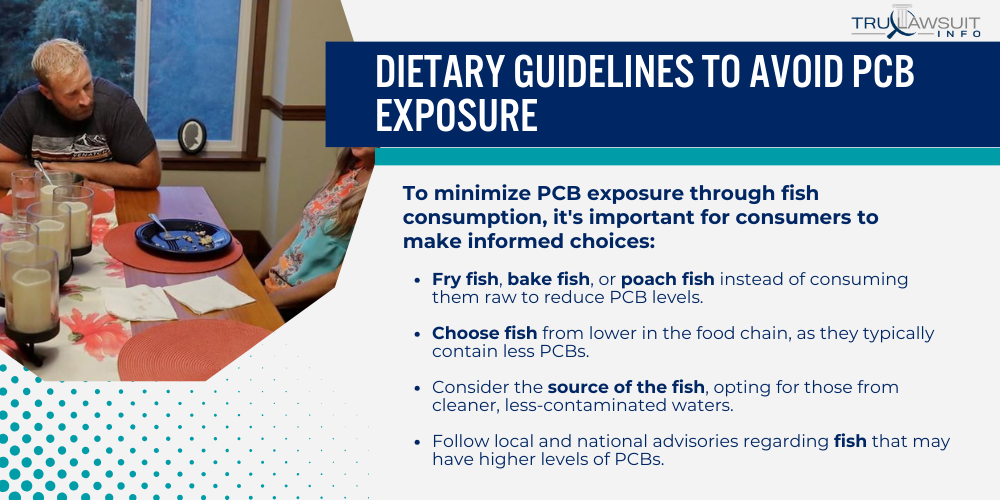
By adhering to specific dietary guidelines, individuals can significantly reduce their PCB intake.
Fish Consumption Tips
Individuals should be strategic about their fish choices and preparation methods.
Prioritizing fish species known for lower PCB accumulation and being mindful of their origin can lead to safer consumption habits.
To minimize PCB exposure through fish consumption, it’s important for consumers to make informed choices:
- Fry fish, bake fish, or poach fish instead of consuming them raw to reduce PCB levels.
- Choose fish from lower in the food chain, as they typically contain less PCBs.
- Consider the source of the fish, opting for those from cleaner, less-contaminated waters.
- Follow local and national advisories regarding fish that may have higher levels of PCBs.
Selecting and Preparing Meats and Dairy
Mindful selection and preparation of meats and dairy products can play a crucial role in minimizing dietary intake of PCBs.
Emphasizing low-fat options and proper cooking techniques helps reduce PCB consumption, as these compounds are primarily stored in animal fats
When selecting and preparing meats and dairy products to avoid PCBs, consumers should focus on the fat content:
- Opt for low-fat dairy products over full-fat options to reduce PCB intake.
- Trim visible fatty tissues from meats, as PCBs are more likely to accumulate in fat.
- Choose lean cuts of meat and consume in moderation.
- Prefer cooking methods that allow fat to drip away from the meat, as PCBs are stored in fat.
Avoiding PCBs: Minimizing Household Risks
Polychlorinated biphenyls (PCBs) are chemical compounds that can pose significant health risks.
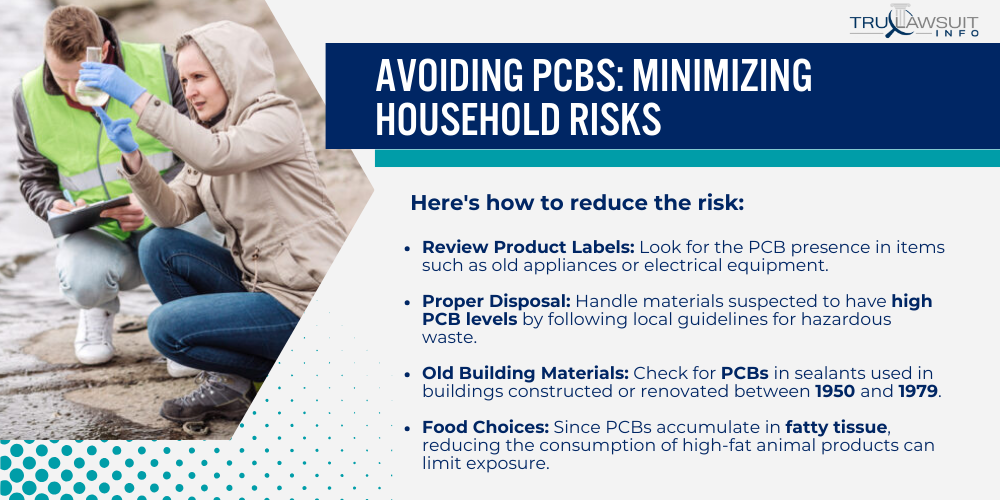
Reducing exposure in the home involves careful identification of potential sources and protective measures, especially for vulnerable groups such as children and breast feeding women.
Identifying and Avoiding Contaminated Products
The first step in minimizing PCB exposure is to identify potential sources in the household.
PCBs may be present in various forms, from oily liquids to sticky solids, and they primarily accumulate in the fatty tissues of living organisms.
Here’s how to reduce the risk:
- Review Product Labels: Look for the PCB presence in items such as old appliances or electrical equipment.
- Proper Disposal: Handle materials suspected to have high PCB levels by following local guidelines for hazardous waste.
- Old Building Materials: Check for PCBs in sealants used in buildings constructed or renovated between 1950 and 1979.
- Food Choices: Since PCBs accumulate in fatty tissue, reducing the consumption of high-fat animal products can limit exposure.
Elevated Risks for Sensitive Groups
Certain groups are at a higher risk of adverse effects from PCB exposure.
Breastfeeding mothers, children, and people with existing health conditions should take additional precautions:
- Breastfeeding: Although breast milk is the best nutrition source for infants, it can contain PCBs if the mother has been exposed. Women should seek professional advice to balance the benefits of breastfeeding with potential risks.
- Children’s Play Areas: Ensure areas where children play are free of PCBs, as their bodies are more susceptible to toxic effects.
- Regular Medical Check-ups: Early detection of PCB exposure can lead to better management, particularly for sensitive groups.
- Dietary Caution: Educate children on choosing lower-fat foods that are less likely to contain concentrated PCBs.
PCB Exposure Regulations and Guidelines
Understanding PCB exposure regulations and the importance of guidelines can greatly reduce the risks associated with these hazardous chemicals.
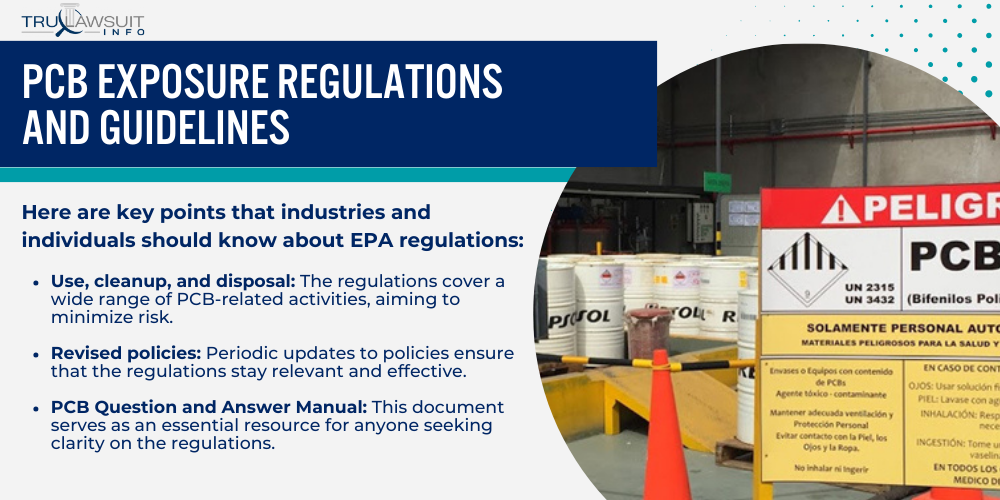
The Environmental Protection Agency (EPA) has established comprehensive standards, which, together with global and community efforts, aim to protect both health and the environment from PCB contamination.
EPA and Global Standards
The EPA has a robust set of regulations governing PCBs to ensure environmental safety and public health.
Here are key points that industries and individuals should know about EPA regulations:
- Use, cleanup, and disposal: The regulations cover a wide range of PCB-related activities, aiming to minimize risk.
- Revised policies: Periodic updates to policies ensure that the regulations stay relevant and effective.
- PCB Question and Answer Manual: This document serves as an essential resource for anyone seeking clarity on the regulations.
Among global standards, various countries have their own regulations which are often aligned with those of the EPA.
This combination of local and international guidelines helps to create a comprehensive framework for PCB management worldwide.
Community and Environmental Advocacy
The role of community groups and environmental advocates in pushing for strong PCB regulations cannot be overstated.
They are often at the forefront of:
- Monitoring compliance: Ensuring that local and federal regulations are observed.
- Educating the public: Raising awareness about PCB risks and safety measures.
- Promoting transparency: Advocating for clear communication from industries about PCB usage and disposal.
- Supporting legislation: Pushing for laws that protect community health and the environment.
Monitoring and Reporting PCB Contamination
Effective monitoring and reporting are critical in managing the risks associated with PCB contamination.
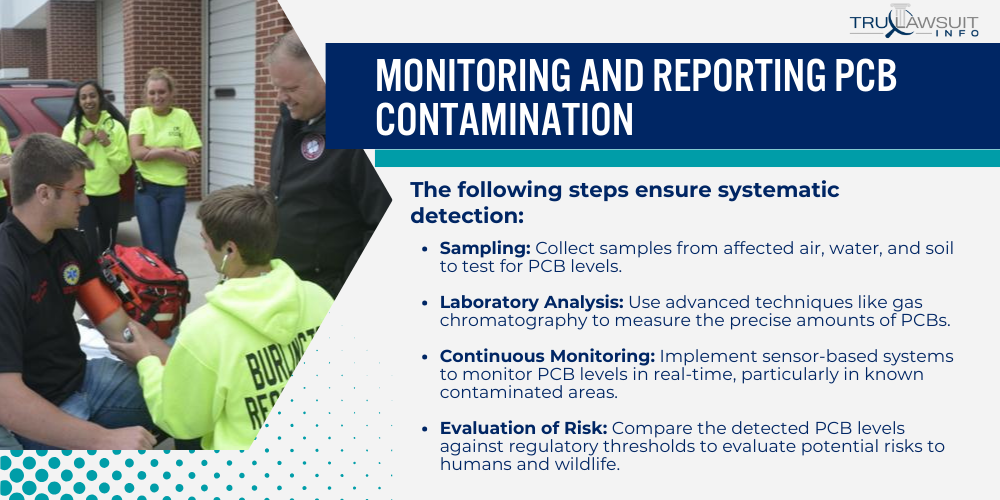
They involve detecting PCB levels and conducting health surveillance, with findings communicated clearly to the relevant authorities and the public.
Detecting PCB Levels in the Environment
Assessing the PCB levels in various environments requires a comprehensive approach.
The following steps ensure systematic detection:
- Sampling: Collect samples from affected air, water, and soil to test for PCB levels.
- Laboratory Analysis: Use advanced techniques like gas chromatography to measure the precise amounts of PCBs.
- Continuous Monitoring: Implement sensor-based systems to monitor PCB levels in real-time, particularly in known contaminated areas.
- Evaluation of Risk: Compare the detected PCB levels against regulatory thresholds to evaluate potential risks to humans and wildlife.
- Thermal Imaging: Use extreme temperature-sensitive equipment to identify PCB hotspots, as thermal degradation processes can release PCBs into the environment.
- Unexpected Sources: Investigate for unexpected sources of PCBs, such as old electrical equipment or building materials.
Health Surveillance and Public Reporting
Health surveillance is a crucial step in managing the consequences of exposure to large amounts of PCB poisoning.
A structured surveillance process involves the following:
- Medical Screenings: Conduct regular health check-ups on individuals at risk of exposure to PCBs.
- Population Studies: Analyze health data from communities living near contaminated areas to identify patterns.
- Employment Records: Review work history records to assess occupational exposure to PCBs.
- Public Health Advisories: Inform the public about safe levels of exposure and precautions to take when dealing with PCBs.
- Treatment Guidance: Provide clear instructions on treatment for those with high PCB levels in their bodies.
- Educational Programs: Develop programs to raise awareness on the prevention of PCB contamination.
Future Perspective to Reduce PCB Exposure Rates
Tackling the persistent threat of PCBs involves innovations in technology and a reinforced global commitment to eradication.
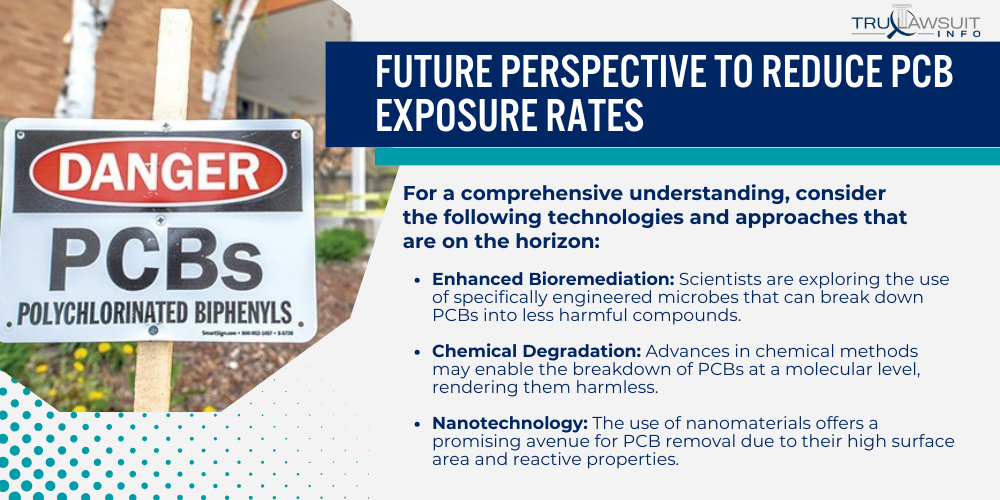
These efforts are crucial due to the long periods during which PCBs remain in the environment, their propensity to be easily absorbed by living organisms, and the resulting increased risk at higher concentrations.
Advancements in Remediation Technology
Significant advancements in remediation technology can be anticipated in efforts to manage and neutralize the risk posed by PCBs.
These developments are designed to improve the efficiency and effectiveness of decontamination processes.
For a comprehensive understanding, consider the following technologies and approaches that are on the horizon:
- Enhanced Bioremediation: Scientists are exploring the use of specifically engineered microbes that can break down PCBs into less harmful compounds.
- Chemical Degradation: Advances in chemical methods may enable the breakdown of PCBs at a molecular level, rendering them harmless.
- Nanotechnology: The use of nanomaterials offers a promising avenue for PCB removal due to their high surface area and reactive properties.
- Electrokinetic Remediation: This approach uses electrical currents to mobilize PCBs for easier extraction from soils and sediments.
Promoting Global PCB Elimination
The campaign for worldwide PCB elimination calls for a concerted effort that spans numerous nations and industries.
Essential actions include:
- Ratification of International Agreements: Countries can join forces by ratifying agreements like the Stockholm Convention, which mandates the sound management of PCBs by 2028.
- Implementation of Legislation: National laws must enforce the ban on PCB production and mandate the safe disposal of PCB-containing materials.
- Public Awareness Campaigns: Education on the dangers of PCBs can lead to increased public support for regulatory measures and safer practices.
- Financial and Technical Support for Developing Nations: Developed countries can provide resources to assist less affluent nations in PCB management and disposal.
By strategizing these global actions, stakeholders aim to drastically reduce PCB exposure rates and safeguard both the environment and public health.
Frequently Asked Questions
-
What measures can reduce the risk of PCB exposure in households?
To reduce the risk of PCB exposure in households, individuals should inspect electrical equipment for damage, ventilate indoor areas, clean frequently, discard old fluorescent light ballasts, and consult professionals about removing sealants or caulks from buildings constructed between 1950 and 1979.
These precautions will help minimize the accumulation of airborne PCBs and reduce the risk of exposure.
-
What are the best practices for disposing of electronics to minimize PCB contamination?
To minimize PCB contamination when disposing of electronics, it is best to identify and separate older electronics that are more likely to contain PCBs and utilize authorized hazardous waste disposal services or certified e-waste recyclers that follow environmentally safe procedures.
Additionally, participating in community electronic waste collection events can also ensure safe processing.
-
Can you elaborate on the methods for decontaminating areas affected by PCBs?
PCBs can be effectively decontaminated by following a methodical approach that includes segregation, chemical or thermal decontamination, proper disposal, and thoroughly cleaning the affected area with agents designed to neutralize PCBs.
It is important to comply with regulatory guidelines and utilize environmental agency recommendations for safe and effective decontamination.
-
In what ways can we prevent PCB exposure through dietary choices?
Individuals can prevent PCB exposure through dietary choices, such as consuming fish from known sources or those certified as low in PCBs.
Trimming fat from meat and removing skin from poultry to reduce PCB ingestion, consulting fish advisories that report levels of PCBs and suggest consumption limits, and choosing a variety of foods to lessen the probability of consuming high levels of PCBs from a single source.
-
What are the procedures to follow in case of accidental PCB spill or contact?
In case of accidental PCB spill or contact, the immediate action required is to isolate the area to prevent PCBs from spreading and wash any skin that has come into contact with PCBs with soap and water.
Contact TruLawsuit Info using the chat on this page to receive an instant case evaluation to file a PCB Exposure Lawsuit.

Experienced Attorney & Legal SaaS CEO
With over 25 years of legal experience, Jessie is an Illinois lawyer, a CPA, and a mother of three. She spent the first decade of her career working as an international tax attorney at Deloitte.
In 2009, Jessie co-founded her own law firm with her husband – which has scaled to over 30 employees since its conception.
In 2016, Jessie founded TruLaw, which allows her to collaborate with attorneys and legal experts across the United States on a daily basis. This hypervaluable network of experts is what enables her to share reliable legal information with her readers!
Have A Case?
Here, at Tru Lawsuit Info, we’re committed to helping victims get the justice they deserve.
To do this, we actively work to connect them with attorneys who are experts in litigating cases similar to theirs.
Would you like our help?
Tru Lawsuit Info is a reliable source of information about issues that may affect your health and safety, such as faulty products, data breaches, and environmental hazards.
Our team of experienced writers collaborates with medical professionals, lawyers, and advocates to produce informative articles, guides, and other resources that raise awareness of these topics.
Our thorough research provides consumers with access to reliable information and updates on lawsuits happening around the country. We also can connect consumers with attorneys if they need assistance.
Camp Lejeune's water contamination issue spanned several decades starting in the 1950s. Exposure to these chemicals has been linked to various serious health issues, including cancer, organ diseases, and death.
Research is increasingly suggesting a link between the use of Tylenol during pregnancy and the development of neurodevelopmental disorders, such as autism and ADHD, in infants.
Legal action is being taken against manufacturers of Aqueous Film-Forming Foam (AFFF), a chemical used in fighting fires. The plaintiffs allege that exposure to the foam caused health issues such as cancer, organ damage, and birth and fertility issues.
Have A Case?
Here, at Tru Lawsuit Info, we’re committed to helping victims get the justice they deserve.
To do this, we actively work to connect them with attorneys who are experts in litigating cases similar to theirs.
Would you like our help?







